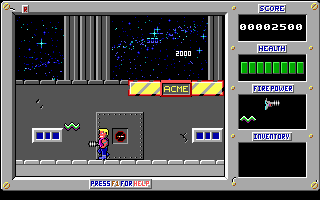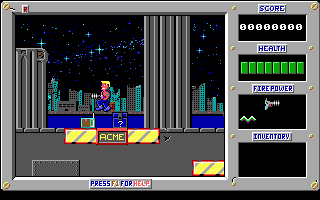Retro Replay Review
Gameplay
Duke Nukem delivers a fast‐paced side‐scrolling shooter experience that combines precision platforming with run‐and‐gun action. Across its three distinct episodes—Shrapnel City, Mission: Moonbase, and Trapped in the Future—players guide Duke through increasingly elaborate levels filled with secret areas, power‐ups, and a broad arsenal of weapons. The control scheme is tight and responsive, allowing you to leap across collapsing platforms, strafe around enemies, and lay down suppressive fire with ease.
(HEY YOU!! We hope you enjoy! We try not to run ads. So basically, this is a very expensive hobby running this site. Please consider joining us for updates, forums, and more. Network w/ us to make some cash or friends while retro gaming, and you can win some free retro games for posting. Okay, carry on 👍)
Each episode introduces unique gameplay twists that keep the action fresh. In Shrapnel City, you navigate industrial corridors and crumbling rooftops, seeking switches to open locked doors and uncover hidden passageways. Mission: Moonbase shakes things up with low‐gravity segments that alter your jump arc and weapon recoil, demanding a more deliberate approach to each firefight. Finally, Trapped in the Future throws hordes of advanced robots and energy weapons at you, forcing you to adapt your strategy on the fly.
Weapon variety is a hallmark of the Duke Nukem series, and this original trilogy is no exception. Starting with a basic pistol, you’ll soon acquire shotguns, pipe bombs, trip mines, and Duke’s signature jetpack. Each tool feels impactful: the shotgun’s spread can clear a room of mutants in seconds, while precision traps like pipe bombs reward careful planning. Combined with tight enemy placement and occasional environmental hazards, the gameplay loop remains compelling from beginning to end.
Graphics
Built on classic VGA technology, Duke Nukem’s pixel art is surprisingly detailed and colorful. Levels are richly decorated with industrial machinery, pulsating alien flora, and futuristic computer consoles, all rendered in a palette that pops on period‐accurate CRT displays. Enemy sprites are distinct—whether it’s a snarling mutant or a sleek robotic sentry—and animation frames capture fluid movement, giving combat a visceral edge.
Each episode brings its own visual identity. Shrapnel City’s gritty steel girders and fiery pitfalls contrast sharply with the sterile corridors and lunar vistas of Mission: Moonbase. Trapped in the Future ups the ante with neon lighting effects and glass‐paneled cityscapes, showcasing the engine’s ability to handle layered backgrounds and parallax scrolling. Though modern standards have moved on, the nostalgic charm of these graphics still shines through.
Duke’s character sprite, complete with his trademark shades and blond flattop, is instantly recognizable and animated with a surprising degree of personality. Enemies react dynamically to damage—smoking, sparking, or collapsing in defeated heaps—while environmental details such as flickering lights and collapsing platforms add a constant sense of peril. For a game of its era, the visual presentation remains a strong selling point.
Story
While Duke Nukem’s storyline isn’t designed to rival epic RPGs, it provides just enough context to drive the action forward. The overarching plot pits Duke against the nefarious Dr. Proton, whose schemes range from industrial sabotage in Shrapnel City to lunar invasion plans in Mission: Moonbase and a time‐bending coup in Trapped in the Future. Each episode opens with a brief text‐oriented introduction, setting the stage without bogging down the pace.
The game’s dialogue is packed with tongue‐in‐cheek one‐liners and 1990s macho swagger, delivered via on‐screen text rather than voice acting. Although minimal, these quips inject personality into Duke’s crusade, reinforcing his status as the ultimate action hero. Players will find themselves chucking at references to pop culture and reveled in the hero’s irreverent attitude as he barrels through enemy strongholds.
Episodes also feature environmental storytelling, with stray logs, computer readouts, and destructible objects hinting at Dr. Proton’s twisted experiments. This subtle world‐building enriches the experience and encourages exploration—even if it rarely alters the main objective of blasting through hordes of bad guys. For players craving narrative depth, the trilogy offers a light yet entertaining backdrop to the non‐stop action.
Overall Experience
Duke Nukem’s original trilogy remains an essential piece of retro gaming history. Its blend of high‐octane combat, clever level design, and cheeky humor delivers a thoroughly satisfying package for fans of classic shooters and platformers alike. Each episode clocks in at a manageable length, offering roughly an hour or two of intense gameplay, yet the hidden secrets and varied challenges make replaying levels worthwhile.
While the absence of modern conveniences—such as in‐game mapping or adjustable difficulty—might frustrate newcomers, veteran players will appreciate the uncompromising challenge and learn to master enemy patterns, secret routes, and resource management. The game runs smoothly on period hardware and can be enthusiastically emulated on contemporary systems, ensuring it’s accessible to anyone eager to experience Duke’s origins.
Overall, Duke Nukem stands as a testament to the creativity and technical prowess of early ’90s game development. Its three episodes each bring distinctive environments and gameplay mechanics, unified by a consistently entertaining hero and a lively sense of humor. Whether you’re a retro aficionado or a curious newcomer, this trilogy offers a captivating dive into action‐packed platform shooting that still holds up decades after its release.
 Retro Replay Retro Replay gaming reviews, news, emulation, geek stuff and more!
Retro Replay Retro Replay gaming reviews, news, emulation, geek stuff and more!









Reviews
There are no reviews yet.